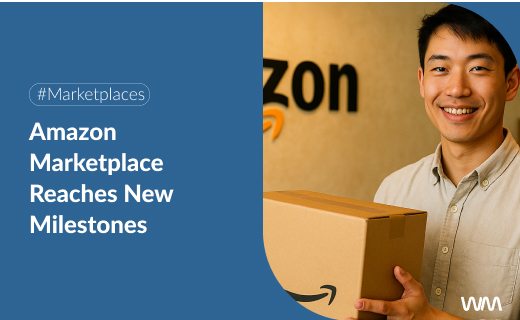A Record-Breaking Year for Amazon: Official Figures and Ecosystem Consolidation
Amazon closed the third quarter of 2025 with historic results. According to data published in its Investor Relations reports and official releases, net sales reached $180.2 billion, a 13% increase compared to the same quarter in 2024.
These numbers confirm Amazon as the most powerful digital infrastructure on the planet, built on a hybrid model where commerce, cloud services, and artificial intelligence coexist.
Marketplace: $2.5 Trillion in Sales and Less Competition
A study published by AMZ Prep places Amazon’s third-party seller ecosystem above $2.5 billion in accumulated sales.
But the big news is not just the growth — it’s the transformation of the market itself:
competition has dropped by 30% over the last two years.
In 2021, there were roughly 2.4 million active sellers; today, estimates suggest that around 1.9 million remain, a reduction of more than half a million.
Fewer players, but stronger ones: those who stay are structured businesses focused on branding, automation, and financial planning.
At the same time, 62% of the products sold on Amazon come from third-party sellers, an all-time high.
Amazon has become a more concentrated — but also more professional — environment.
Why There’s Less Competition (and Why That Can Be Good)
Several factors explain this decline:
- Rising logistics and advertising costs
FBA fees, internal advertising (retail media), and inventory management have raised entry barriers. Competing in 2025 requires a higher initial investment, but it also delivers greater returns when done well. - Greater seller professionalism
New sellers arrive with structure, AI tools, and advanced metrics. Listing a product is no longer enough — you must build a brand. - Regulatory and tax obligations
In Europe, the implementation of the DSA and stricter traceability rules have pushed out less transparent operators.
The result: fewer “opportunistic sellers” and more consolidated companies.
In practical terms, this concentration reduces unfair competition and increases opportunities for those who can scale sustainably.
Data That Confirms the Shift
- In 2024, 55,000 sellers surpassed $1 million in annual sales.
- The average revenue per seller reached $290,000, up 16% from 2023.
- Rural U.S. sellers grew 30% faster than urban sellers.
- The Marketplace generated over 2 million jobs in the U.S., up 11% year-over-year.
- In Spain, Amazon.es averages 1,581 monthly visits per active seller, while Amazon.com surpasses 2,800 visits.
These numbers — according to AMZ Prep and Small Business Trends — reflect a more efficient, segmented, and profitable ecosystem than in previous years.
Artificial Intelligence: The New Referee of the Marketplace
Amazon has integrated AI into every level of the buying journey.
Its Help Me Decide feature analyzes reviews, comparisons, and user behavior to recommend the most suitable product.
This completely changes the rules of internal SEO:
listings with precise descriptions, genuine reviews, and structured data now outperform generic ones.
Operationally, Amazon uses machine learning to predict demand and optimize dynamic pricing.
The result is a marketplace that “self-regulates”: AI decides who sells, when, and at what price.
The Other Side of Success: Liquidity and Reinforcement Speed
In this environment of data and precision, liquidity can become a bottleneck for sellers.
Amazon releases payments every 14 days, a schedule which, in high-rotation categories — electronics, beauty, or food — can lead to lost opportunities.
Every immobilized dollar is unlaunched advertising or unreplenished stock.
This is why solutions designed to keep funds constantly in motion are on the rise — allowing sellers to use their capital to grow.
With such models, each day’s revenue is transferred automatically, enabling sellers to:
- Reinvest in campaigns without waiting weeks
- Keep inventory active and avoid stockouts
- Reduce the need for short-term loans
In a marketplace that moves at full speed, getting paid today for what you sold yesterday is a real competitive advantage.
Wannme does not alter the seller’s relationship with Amazon nor their accounting structure — it simply accelerates the cash cycle.
In mature markets, that speed can be the difference between keeping up and falling behind.
The Future of the Marketplace: Full Professionalization
The top 1% of sellers already accounts for more than 60% of Marketplace sales.
Far from being a threat, this represents a new stage: the maturity of e-commerce.
Possible keys for the coming months:
- Immediate liquidity: daily payments and flexible financing
- Automation and analytics: AI applied to pricing, reviews, and inventory
- Brand differentiation: identity, sustainability, and storytelling
- Regulatory compliance: traceability and e-invoicing
- Omnichannel management: integrating Amazon, Shopify, and social platforms
The future won’t reward those with the most products, but those who combine strategy, technology, and liquidity.
Conclusion: From Seller to Digital Entrepreneur
Amazon Marketplace 2025 is not a mass market, but a selective ecosystem.
Sellers who understand its algorithmic, financial, and operational logic are building real businesses with strong margins and professional management.
Record growth and reduced competition show that success no longer depends on simply being on Amazon — but on how you operate within it.
Ready to manage your Amazon store with a new level of financial control? Contact us and discover how to elevate the way you get paid.






